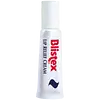What's inside
What's inside
 Key Ingredients
Key Ingredients

 Benefits
Benefits

 Concerns
Concerns

 Ingredients Side-by-side
Ingredients Side-by-side

Petrolatum
EmollientWater
Skin ConditioningTheobroma Cacao Seed Butter
EmollientLanolin
EmollientGlyceryl Stearate
EmollientBehenyl Alcohol
EmollientStearic Acid
CleansingUrea
BufferingCetyl Esters
EmollientPalmitic Acid
EmollientLecithin
EmollientLauryl Alcohol
EmollientMyristyl Alcohol
EmollientCetyl Alcohol
EmollientCamphor
MaskingMenthol
MaskingMethylparaben
PreservativeBHA
AntioxidantEugenia Caryophyllus Leaf Oil
MaskingSucralose
Skin ConditioningPropylparaben
PreservativeAroma
Eugenol
PerfumingPetrolatum, Water, Theobroma Cacao Seed Butter, Lanolin, Glyceryl Stearate, Behenyl Alcohol, Stearic Acid, Urea, Cetyl Esters, Palmitic Acid, Lecithin, Lauryl Alcohol, Myristyl Alcohol, Cetyl Alcohol, Camphor, Menthol, Methylparaben, BHA, Eugenia Caryophyllus Leaf Oil, Sucralose, Propylparaben, Aroma, Eugenol
Water
Skin ConditioningSimmondsia Chinensis Seed Oil
EmollientPolyglyceryl-3 Diisostearate
EmulsifyingCera Alba
EmollientSorbitan Isostearate
EmulsifyingLanolin
EmollientEthylhexyl Salicylate
UV AbsorberButyrospermum Parkii Butter
Skin ConditioningGlycerin
HumectantVitis Vinifera Seed Oil
EmollientAlcohol Denat.
AntimicrobialPEG-6 Almond Glycerides
EmollientStearyl Behenate
EmollientHydrogenated Soy Polyglycerides
Skin ConditioningMentha Piperita Oil
MaskingAroma
Allantoin
Skin ConditioningCamphor
MaskingDimethicone
EmollientOlea Europaea Fruit Oil
MaskingAmmonium Hydroxide
BufferingArachidyl Alcohol
EmollientArachidyl Glucoside
EmulsifyingBehenyl Alcohol
EmollientC15-23 Alkane
SolventCalcium Disodium EDTA
Hydrated Silica
AbrasiveLanolin Alcohol
EmollientLimonene
PerfumingLinalool
PerfumingPhosphoric Acid
BufferingSodium Hydroxide
BufferingSodium Saccharin
MaskingSucralose
Skin ConditioningThymol
AntimicrobialWater, Simmondsia Chinensis Seed Oil, Polyglyceryl-3 Diisostearate, Cera Alba, Sorbitan Isostearate, Lanolin, Ethylhexyl Salicylate, Butyrospermum Parkii Butter, Glycerin, Vitis Vinifera Seed Oil, Alcohol Denat., PEG-6 Almond Glycerides, Stearyl Behenate, Hydrogenated Soy Polyglycerides, Mentha Piperita Oil, Aroma, Allantoin, Camphor, Dimethicone, Olea Europaea Fruit Oil, Ammonium Hydroxide, Arachidyl Alcohol, Arachidyl Glucoside, Behenyl Alcohol, C15-23 Alkane, Calcium Disodium EDTA, Hydrated Silica, Lanolin Alcohol, Limonene, Linalool, Phosphoric Acid, Sodium Hydroxide, Sodium Saccharin, Sucralose, Thymol
 Reviews
Reviews

Alternatives
Ingredients Explained
These ingredients are found in both products.
Ingredients higher up in an ingredient list are typically present in a larger amount.
Aroma refers to an ingredient, or mixture of ingredients, that impart or mask a flavor.
The name is slightly confusing. This is because INCI associates aroma with flavor instead of smell.
Here is the official definition from the The International Cosmetic Ingredient Dictionary and Handbook:
“Aroma is a term for ingredient labeling used to identify that a product contains a material or combination of materials normally added to a cosmetic to produce or to mask a particular flavor.”
INCI shows the only purpose of aroma to be "flavouring".
However, due to regulation differences, some companies may use aroma in place of parfum.
In Canada, this ingredient only has to be listed in concentrations above 1%.
Learn more about AromaBehenyl Alcohol is a type of fatty alcohol (these are different from the drying, solvent alcohols).
Fatty Alcohols have hydrating properties and are most often used as an emollient or to thicken a product. They are usually derived from natural fats and oils; behenyl alcohol is derived from the fats of vegetable oils.
Emollients help keep your skin soft and hydrated by creating a film that traps moisture in.
In 2000, Behenyl Alcohol was approved by the US as medicine to reduce the duration of cold sores.
Learn more about Behenyl AlcoholCamphor is a waxy solid with a strong scent. It is made using turpentine oil.
This ingredient is used for medicinal purposes due to its cooling effect. In medicine, camphor is a common anti-inflammation ingredient.
Camphor also possesses antibacterial and antifungal properties.
One study found camphor to be a potential anti-wrinkle ingredient. This might be due to its ability to increase elastin and collagen production. Collagen and elastin are responsible for plump and youthful looking skin.
It is best to use cosmetics with a small amount of camphor under 11%. Using topical camphor may induce irritation and redness.
In the past, camphor was traditionally made by distilling the wood of the camphor tree.
Learn more about CamphorLanolin is a wax secreted by animals with wool, such as sheep. It is a waterproof emollient.
Emollients help soften and moisturize the skin by creating a film. This film prevents moisture from escaping, helping the skin stay hydrated.
Unlike true fats, lanolin contains sterol esters instead of glycerides. It also contains fatty acids and alcohols.
Because lanolin comes from an animal, it is not considered vegan. Sheep secrete lanolin through sebaceous glands to help protect their skin from the environment.
The answer to this question depends on the brand itself. Being cruelty-free means a brand does not experiment or harm animals. We recommend looking into how brands source their lanolin. Lanolin is cruelty-free if it is gathered without harming the animal.
Learn more about LanolinWe don't have a description for Sucralose yet.
Water. It's the most common cosmetic ingredient of all. You'll usually see it at the top of ingredient lists, meaning that it makes up the largest part of the product.
So why is it so popular? Water most often acts as a solvent - this means that it helps dissolve other ingredients into the formulation.
You'll also recognize water as that liquid we all need to stay alive. If you see this, drink a glass of water. Stay hydrated!
Learn more about Water